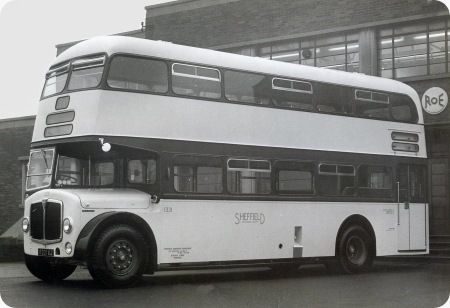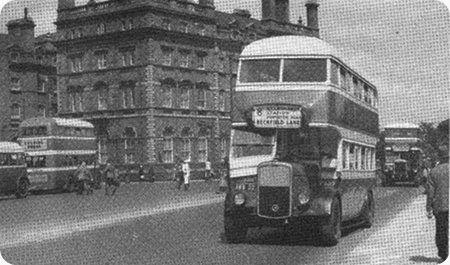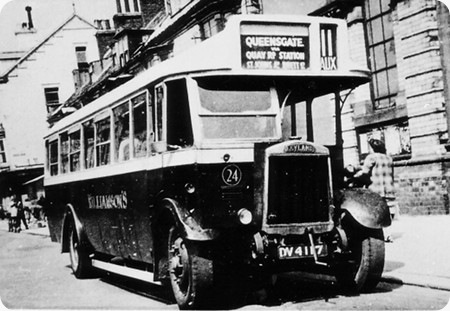
Sheffield Corporation
1960
AEC Regent V 2D3RA
Roe H39/30RD
This was part of another big order that Sheffield placed with AEC in this case for a total of 71 Regent V 2D3RA model, all delivered in 1960.
1331 was part of the B fleet contingent of 25 buses all of which had this style of Roe bodywork whilst the A fleet received vehicles bodied by Weymann and Alexander.
Items to note in comparison with Roe bodied Leyland PD3 fleet number 462 delivered the year previously is the reduction in the number of sliding windows by two in each side of each deck but the inclusion of vents in the front top deck windows plus of course the addition of platform doors. These were manually operated by the conductor and would no doubt be appreciated on some of the longer services such as the 72 to Castleton in the Peak District. I have a watercolour painting done for me many years ago by a good friend of one of this batch operating on service 72 between Bamford and Hathersage.
Comparing this bus with Roe bodied Regent III fleet number 1265, the change of livery to include a cream painted radiator surround gives the bus a lighter appearance whilst in this case the legal owner is Sheffield Transport Department.
Although many of this batch were withdrawn in 1972 (maybe at the expiry of their second CoF – 7 years initially plus 5 years recertification), my PSV Circle fleet list shows this bus as still in service in October 1973.
This is another Coachbuilders official photograph taken at the Roe premises in Crossgates, Leeds.
Photograph and Copy contributed by Ian Wild
A full list of Regent V codes can be seen here.
———
04/05/11 – 11:49
Here we have it, Ian. My absolute favourites from my Sheffield childhood. Although, for the most part, built at the end of 1959, only about half were delivered on 1 January 1960, the rest were delivered on 1 April with the residue of Weymann and Alexander buses.
There was a minor difference in that one sub set had an extra slider (on each side) just behind the bulk-head inside. I think these were what I called the Leadmill set – found on the 12, 22 and 59. The East Bank set were delivered in April and were put to work on the 38. It leads me to surmise that 1331 was an April, East Bank, bus. [Often, lower fleet numbers seemed to arrive before higher ones.]
I’m still hoping that 1330, at Aldwarke, will eventually be rebuilt and take to the road.
David Oldfield
———
05/05/11 – 07:05
A classic photograph, with the fluorescent lights fully on in what was apparently the Roe drawing office in the background, where these wonderful bus bodies were designed and detailed!
1331 as it happens was the last Roe bodied Regent V in service at Sheffield, being finally withdrawn on 13 May, 1976. The other three of the batch which accompanied 1331 into that last year of back loader operation were 1332, 1336 and 1339, the three of them coming off the previous month. For the record, 1331 completed a full last day in service on that May day, shuttling back and forth between Sheffield Lane Top and Bradway on the 76; a fine testament to a superb vehicle.
Dave Careless
———
05/05/11 – 12:16
Bradway (75)? or Lowedges Road (76)?
David Oldfield
———
06/05/11 – 06:59
To all, interest in the Sheffield Transport/SJOC matters are certainly gaining momentum!
The comments on the later intake of Leyland PD2/20 and 30, followed by the longer PD3/1 vehicles is a very interesting point. Undoubtedly, the problem of the Leyland change in the gearbox specification was a hard blow, particularly with respect to the newly trained, ex tram drivers. Possibly Leyland thought that Sheffield would turn to the Pneumocyclic option. The 40 PD2/20 Roe bodied batch in 1956 were taken into the A fleet, featuring the latest constant mesh/synchromesh gearbox. They were mainly replacement buses and would be driven by experienced drivers. Conversely, as time went by, the former tram men gained more driving experience and were able to master the buses lacking synchromesh on 2nd gear. Very definitely the 30ft long PD3/1/Roe buses, much heavier than the PD2 versions,were a problem to many skilled drivers,on steeply graded routes. To this end, the Chief Driving Instructor Charles Deamer devised a method of "Snatch changing" (a brutal change from 1st to 2nd gear) when starting on steep hills and this method was also used on the PD2’s. However, the driving staff preferred the easier life when in control of the AEC Regent Mark 111 and Mark V versions of 27ft and 30ft buses. Manager C.T.Humpidge re-introduced fluid transmission/Monocontrol to Sheffield A,B,& C fleets in 1964/5 and no further synchromesh buses entered service.
Keith Beeden
———
06/05/11 – 07:19
Well David, it was a long time ago! Perhaps it did a stint on both, but all I can say is that it was out all day, didn’t break down, and definitely wasn’t on the 33 from Lane Top to Hemsworth!!
1331 had a spell at Bramall Lane garage early in its career, as it shows up there in the allocation list dated 11th January, 1963, (with eight of its sisters, 1325-1330, 1332 and 1349) but that garage closed later that year, so presumably was an East Bank bus after that for most if not all of its working life. Fascinating hobby this, isn’t it!
Dave Careless
———
06/05/11 – 15:36
Certainly is and its good to know there are other Sheffield expert/enthusiasts out there. We may be outnumbered by the West Yorkshire lot and we can’t post as long as East Yorkshire but we will fly the flag for the People’s Republic of South Yorkshire (!!!).
David Oldfield
———
07/05/11 – 06:06
At PMT all the Leyland Titans, both PD2 and PD3 had the Leyland GB83 constant mesh second gearboxes. The driving school there taught the snatch change method of getting from 1st to 2nd on a hill start. Although not in the same league as Sheffield, the Potteries area did have a number of steep hills to negotiate. Once you got the hang of it, the snatch change was quite easy. The gear lever travel on the GB83 was much shorter than on the synchromesh second unit (think that was a GB74) which made the buses so fitted that much easier to drive. I queried the non use of synchro 2nd gearboxes at PMT and was told that the constant mesh 2nd gearbox had a generally longer service life between repairs. Even the Matador recovery vehicle had acquired a Leyland 0.600 engine and a GB83 gearbox!
Ian Wild
———
09/05/11 – 08:16
The Sheffield thread is fascinating. My brother-in-law-to-be was doing a practical stint at Laycock’s in 1960, so I went up to join him for a couple of days and we went merrily tram-riding only months before closure. My very favourites were the 1937 batch, but they were all very stylish, so it’s fitting that the 1959-60 Regents (which I assume were the tram-replacement batches) were so handsome. Even the Bridgemaster (not usually a favourite of mine) is well-proportioned—with the bonus of a prodigious seating capacity.
Keith Beeden’s point about hardened gearwheels is an eye-opener: I knew that many variables affected the music of the same gearbox in different vehicle types, but I never realised that mere (!?) metallurgy could play such a part. But it makes sense: cardboard gearwheels wouldn’t sing. Could the hardened teeth that Keith mentions have been used in the NTG…-reg 1954 Rhondda Regent IIIs? They certainly had a distinctive whine.
I’ve never driven a PD2 (except for an RTW) so I don’t know whether a clutch stop was fitted or not, but it certainly should have been! A clutch-stop would save wear on the cones when engaging 1st or 2nd from neutral, but I guess the builders judged that synchromesh had made that wonderful, simple device redundant.
Ian Thompson
———
09/05/11 – 08:19
A driver at Manchester once told me that the problem with the snatch change from first to second on the half-synchro PD2s was that every bus was different. Some required more skill than others, and some would not accept a snatch change no matter what. He found it more reliable to move the lever out of first, across the gate and gently forward, slowing the clutch down on third gear synchromesh, and then snick it quickly back into second.
Peter Williamson
———
10/05/11 – 07:13
A very ingenious solution, Peter!
Chris Hebbron
———
10/05/11 – 07:15
Ian, I agree with you about the Sheffield Domed trams (1936 – 1939 + war-time rebuilds). The majority of the tram replacement buses were 27′ Regents and Titans and I think, strictly, the only 30′ Regent V tram replacement buses were the Weymann and Alexander examples (A fleet). The Roe were B fleet – and there were no B fleet trams!
I also agree with you about the Bridgemaster which looked good in Sheffield colours and with the traditional back end. It was the front loader which looked all wrong.
Was never aware that the Bridgemasters caused any problems with reliability. That being the case, what was really the problem with it? Interesting to think of a comment I read that AEC pondered the possibility of replacing the Regent V AND the Bridgemaster with the Renown. Again, never heard of reliability problems with them either. …..unless anyone out there knows otherwise.
David Oldfield
———
12/05/11 – 9:39
Thanks for the clarification, David. I’ve never understood the Sheffield A-fleet/B-fleet distinction though, so perhaps you could outline that for me as well.
Ian Thompson
———
A Fleet: wholly owned by Sheffield Corporation for routes entirely within the City bounds, including those which replaced tram routes.
B Fleet: owned jointly by Sheffield Corporation and the Railway Companies or Boards. [Sheffield expanded its borders progressively from about 1920 until 1974. B fleet routes included some on the outer edge of the City which had previously been in Derbyshire or the West Riding and some which went over the borders.]
C Fleet: owned entirely by the Railway Companies or Boards. These routes included some Derbyshire routes but also all the long routes, including Manchesters and Retford/Gainsboroughs. For most, although not all, of its existence, C Fleet buses shared the same livery and generally similar types to the A (and B) Fleet.
Management of all three fleets and routes was common, types of vehicle were similar (although platform doors and different seats may differentiate) and, of course, coaches would be B and C Fleet.
The JOC (Joint Omnibus Committee) was set up in 1927 principally with the LMS and LNER Railways. With Nationalisation in 1948 these became Midland and Eastern Regions. The formation of NBC in 1969 caused the disbandment of the JOC – which had in effect performed as a regional bus company such as, and in the territory of, Yorkshire Traction and North Western. Many C Fleet buses were then, at this time, dispersed among NBC subsidiaries, notably Yorkshire Woolen. JOCs seemed to be a very Yorkshire thing – Halifax, Todmorden, Huddersfield – although Railways always had a stake in BET and Tilling companies as well prior to NBC formation.
Although the Corporation retained most Derbyshire work, the remaining Manchester route (48) became a North Western operation and many of the others became joint with operators with whom they had previously work anyway.
David Oldfield
———
 Vehicle reminder shot for this posting
Vehicle reminder shot for this posting
———
16/01/12 – 16:34
A somewhat belated response to the comment on snatch gear changes with Leyland PD2’s and PD3’s. I learned to drive in a PD1 in 1962 and was taught the technique at that time, as this was with Eastbourne Corporation there being no serious hills to contend with I can’t remember having to use it. However I joined Southdown in 1969 at Eastbourne and soon had cause to brush up the trick especially on the 12 route to Brighton which also included trips to estates at West Dene and Tongdean on the outskirts of Brighton which were very hilly (one reason the PD3/5’s went west). Probably the worst stop was at Downs Golf club 2/3rd’s of the way up the hill out of Eastbourne, not something you looked forward to with a good load of holidaymakers in the summer. I’ve never heard of the trick told to Peter Williamson, of using the synchro on 3rd gear to slow the gearbox when changing 1st to 2nd but I did use the same method but using 4th to make selecting 2nd gear when stationary much easier and quieter otherwise 2nd would grate noisily, I read this somewhere but can’t remember where. The same technique worked equally well when used with the direct air operated Pneumocyclic box as it cut out the jolt when engaging 2nd when stationary.
Diesel Dave





